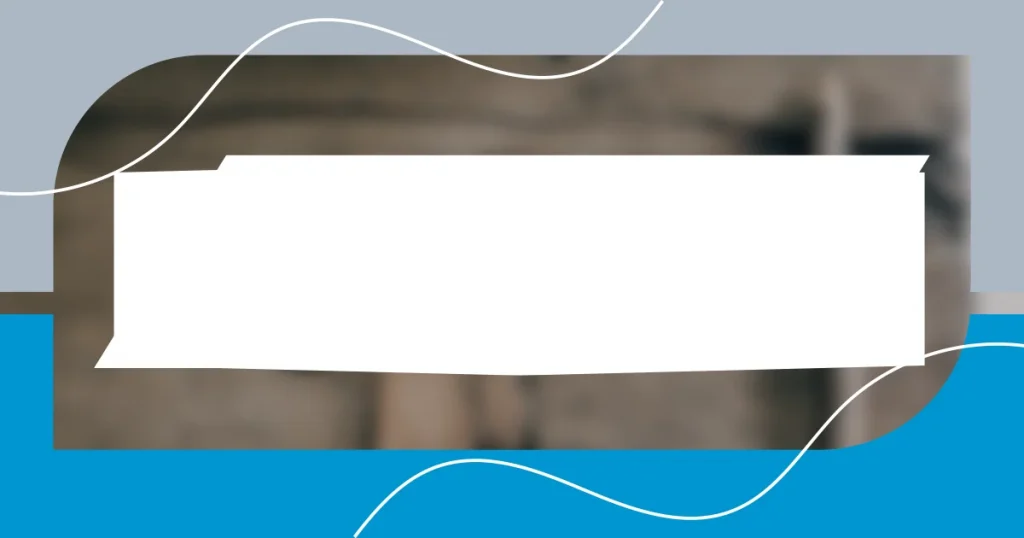Key takeaways:
- Start with thorough cleaning, removing hardware, and inspecting for damages to ensure a solid foundation for refinishing.
- Key steps in the refinishing process include stripping the old finish, meticulous sanding, and applying stain or paint followed by a protective topcoat.
- Avoid common mistakes such as rushing through sanding, neglecting stain tests, and forgetting proper ventilation while working with chemicals.

Understanding furniture refinishing process
Refinishing old furniture is truly a labor of love. I still remember the first time I took an old, scratched dining table and transformed it into a centerpiece of our home. It was a fascinating journey; each step felt like uncovering a piece of history, and I found myself admiring the craftsmanship that had endured through the years.
The process typically starts with stripping off the old finish, which can be a bit daunting. I remember the first time I applied a chemical stripper and felt that mix of excitement and anxiety when peeling away layers to reveal the wood beneath. Have you ever experienced that thrill of seeing potential emerge from something worn? It’s an incredibly rewarding sensation.
Once the surface is prepared, sanding is crucial to ensure a smooth finish. I learned the hard way that rushing through this step can lead to uneven results, and I once ended up with a blotchy finish on a beautiful side table. Patience is key here! Taking your time during sanding can make all the difference, highlighting the natural beauty of the wood and allowing your chosen stain to shine.

Preparing old furniture for refinishing
Preparing old furniture for refinishing involves several essential steps that set the foundation for a beautiful transformation. First, I like to start by cleaning the piece thoroughly. On one occasion, I found an old chest of drawers that had decades of dust and grime. After scrubbing it down with a gentle cleaner, you could almost hear the wood breathe again—such a satisfying moment!
Next up is removing hardware and any loose parts. This step is often overlooked, but it makes a noticeable difference. I once took apart a vintage dresser, only to discover hidden compartments that had been long neglected. I couldn’t believe my luck! Plus, taking everything apart allows for a more thorough refinishing process, ensuring every nook and cranny gets the attention it deserves.
Lastly, inspecting the wood for damages is critical. I recall almost missing a significant crack in a beautiful table leg during my first project. Noticing these flaws early on means you can fill them with wood filler or make necessary repairs before applying the finish. It’s one of those details that elevated my work from good to exceptional, and it’s fascinating how these small actions can completely change the outcome of your project.
| Step | Details |
|---|---|
| Cleaning | Thoroughly clean the piece to remove dust and grime for a fresh start. |
| Removing Hardware | Take off all knobs and handles, uncovering any hidden compartments, ensuring an even refinishing process. |
| Inspecting for Damages | Check for cracks or damages; repair them before starting the refinishing. |

Step by step refinishing techniques

Step by step refinishing techniques
As you dive into the refinishing process, I always recommend starting with stripping the old finish. The first time I did this, I felt like an archaeologist peeling back time! Watching the layers reveal the raw wood was mesmerizing. After stripping, it’s vital to sand the surface meticulously. I’ve learned the hard way that skipping this step leads to a lackluster finish that just doesn’t do justice to your hard work.
Here’s a concise breakdown of the crucial steps in refinishing:
- Strip the old finish: Use a chemical stripper to remove grime and coatings; this sets the stage for a fresh start.
- Sanding: Employ different grits for an ultra-smooth surface; trust me, this step is worth every minute spent.
- Cleaning after sanding: Wipe down the surface to remove dust, ensuring a ready surface for stain or paint.
- Applying stain or paint: Choose your desired color; I love how the rich tones of wood really bring a piece to life. Apply with a brush or cloth for even coverage.
- Sealing: Finish with a protective topcoat—this ensures durability and brings out the best in your refinished piece. I remember the satisfaction of finally applying that topcoat; it felt like sealing in my hard work and transforming a dull piece into something special.
With each step, you not only breathe new life into the furniture but also build a connection with it. I still have the side table from my first project, and every scratch tells a story of the effort I put in. Whether it’s a new home for a beloved piece or simply a DIY adventure, the journey of refinishing is as beautiful as the final result.

Common mistakes to avoid
One common mistake I see often is rushing the sanding process. I remember when I tackled my first chair; I was so eager to see the final product that I hurried through the sanding. The result? An uneven surface that completely undermined my efforts. Taking your time here is crucial—patience truly pays off.
Another pitfall is neglecting to test your stain or paint beforehand. The first time I skipped this step, I was shocked at how different the final color looked compared to what I envisioned. It’s like ordering food and getting a surprise dish! Always try a small test patch on an inconspicuous area to avoid disappointment and ensure the hue is just right.
Finally, I’d caution against forgetting proper ventilation while working with chemicals or paints. Early on, I didn’t open a window when stripping an old dresser. The fumes were overwhelming, and honestly, it took some time to recover my focus. Keeping your workspace fresh not only protects your health but also enhances your overall refinishing experience.
















